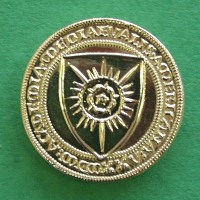Loading AI tools
Riconoscimento Da Wikipedia, l'enciclopedia libera
La Medaglia Haskins è un riconoscimento annuale della Medieval Academy of America (MAA) per la migliore monografia di studi medievistici.[1]

La prima edizione del premio fu nel 1940, quando la medaglia fu nominata in onore dello storico medievista Charles Homer Haskins, uno dei soci fondatori della MAA, nonché suo secondo presidente.[2] Il nome del vincitore viene annunciato in occasione della riunione annuale che si svolge in primavera.
La medaglia, progettata da Graham Carey nel '39, sul lato verso riporta il nome del vincitore e l'anno di assegnazione.
La Medaglia Haskins è stata vinta dai seguenti studiosi:[3]
Seamless Wikipedia browsing. On steroids.
Every time you click a link to Wikipedia, Wiktionary or Wikiquote in your browser's search results, it will show the modern Wikiwand interface.
Wikiwand extension is a five stars, simple, with minimum permission required to keep your browsing private, safe and transparent.